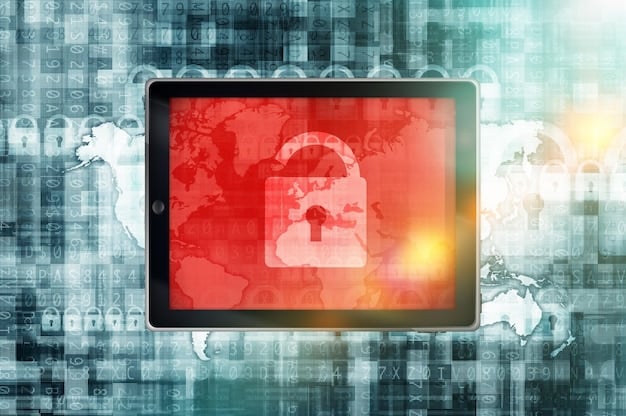Streaming Service Security: Protecting Your US Account in 2025

Keeping your streaming service accounts secure from hackers in the US in 2025 demands proactive measures, including strong, unique passwords, activating multi-factor authentication, and regularly monitoring account activity to prevent unauthorized access and data breaches.
In 2025, the digital landscape of entertainment is dominated by streaming services, becoming integral to daily life for millions across the US. However, this convenience comes with a growing concern: the vulnerability of our accounts to malicious actors. Understanding and implementing robust strategies for Streaming Service Security: Protecting Your Account from Hackers in the US (2025) is no longer just recommended—it’s essential for safeguarding your personal data and uninterrupted entertainment.
The Evolving Threat Landscape in 2025
The digital world never stands still, and neither do cyber threats. As streaming services evolve, so do the methods employed by hackers. In 2025, the landscape of online attacks is more sophisticated, personalized, and persistent than ever before, posing significant risks to your digital entertainment life.
Understanding these evolving threats is the first step in formulating an effective defense strategy. Cybercriminals are constantly adapting, finding new vulnerabilities and exploiting human error to gain unauthorized access to accounts. Their motivations range from selling stolen credentials on the dark web to using hijacked accounts for various fraudulent activities, impacting not only your subscription but potentially your broader digital identity.
The sheer volume of personal data now associated with streaming accounts makes them attractive targets. From payment information to viewing habits, this data can be leveraged for identity theft or targeted phishing campaigns. Therefore, a comprehensive security approach must consider these multi-faceted attack vectors.
Phishing and Social Engineering Scams
Phishing remains one of the most prevalent and effective tactics. In 2025, these scams are increasingly sophisticated, often mirroring legitimate service communications. They aim to trick users into divulging login credentials or other sensitive information.
- Realistic Impersonations: Emails and messages often mimic official streaming service branding, making them difficult to distinguish from genuine communications.
- Urgency and Fear Tactics: Scammers create a sense of urgency, threatening account suspension or service interruption if immediate action is not taken.
- Deepfakes and Voice Scams: Advanced social engineering might incorporate AI-generated deepfakes or voice impersonations to make requests seem more legitimate.
Social engineering exploits human psychology, leveraging trust and curiosity to bypass technical security measures. Users must be particularly vigilant about unsolicited messages, even if they appear to originate from known sources.
Credential Stuffing and Brute-Force Attacks
These automated attacks capitalize on weak or reused passwords. Credential stuffing involves using lists of stolen usernames and passwords from other data breaches to try and log into streaming services.
Brute-force attacks involve systematically trying every possible password combination until the correct one is found. While less efficient for individual accounts, these methods can be highly successful on a large scale if passwords are short, simple, or predictable.
The primary defense against these attacks lies in password hygiene. Unique, strong passwords for each service significantly reduce the risk, as a breach on one platform won’t compromise another.
The threat landscape is dynamic and requires continuous education and adaptation from users. Staying informed about the latest cyber threats is just as crucial as implementing technical safeguards. Our collective vigilance can create a more secure digital environment for everyone in 2025.
Implementing Robust Password Practices
Your password is the first, and often the last, line of defense against unauthorized access to your streaming accounts. In an era where data breaches are unfortunately common, establishing robust password practices is paramount for every digital user. A strong password isn’t just a recommendation; it’s a fundamental pillar of your online security strategy.
Weak or re-used passwords are an open invitation for hackers. Once a single account is compromised due to a poor password, it creates a domino effect across all other services where that same password is used. This is why investing time and effort into creating and managing secure passwords pays dividends in long-term digital safety.
The goal is to create passwords that are complex enough to deter automated attacks but memorable enough for you to use without constant retrieval. Balancing these two aspects is key to effective password management.
Generating Strong, Unique Passwords
A strong password is typically long, complex, and unique. Trying to memorize dozens of such passwords can be daunting, which is where password managers become indispensable tools. These applications securely store all your login information, allowing you to use complex passwords for every account without the need for memorization.
- Length is Key: Aim for passwords of at least 12-16 characters. Longer passwords are exponentially harder to crack.
- Mix Character Types: Combine uppercase and lowercase letters, numbers, and symbols. This adds significant complexity.
- Avoid Personal Information: Do not use names, birthdays, pet names, or easily guessable information.
- Uniqueness Across Services: Never reuse passwords across different streaming services or other online platforms. A breach on one service could compromise all others using the same password.
Many streaming services now offer password strength indicators during the creation process, which can guide users towards more secure choices. Pay attention to these indicators and strive for the “strong” rating.
Utilizing Password Managers
Password managers act as a digital vault for your credentials. They can generate strong, unique passwords for each of your streaming services and automatically fill them in when you need to log in. This significantly reduces the burden of remembering complex combinations and enhances your overall security posture.
Popular password managers like LastPass, 1Password, Dashlane, and Bitwarden offer robust encryption and features like password auditing, which identifies weak or re-used passwords in your vault. Choosing a reputable password manager and securing it with a strong master password and multi-factor authentication are critical steps. This ensures that even if your device is compromised, your stored credentials remain safe.
Regularly reviewing your passwords and updating them, especially after any security alerts, is another good habit. By embracing these password practices, you are building a fort around your streaming accounts, making it much harder for cybercriminals to break in.
Enabling Multi-Factor Authentication (MFA)
Multi-factor authentication, or MFA (sometimes referred to as 2FA for two-factor authentication), adds a crucial layer of security beyond just your password. Even if a hacker manages to steal your password, MFA prevents them from accessing your account because they lack the second verification factor. This makes MFA one of the most effective deterrents against unauthorized access, significantly bolstering your Streaming Service Security: Protecting Your Account from Hackers in the US (2025).
The principle behind MFA is simple: it requires two or more proofs of identity from independent categories of credentials. This could be something you know (your password), something you have (a security token, a smartphone), or something you are (a fingerprint or facial scan). By combining these, the security of your account is exponentially increased.
Most major streaming services now offer some form of MFA, and activating it should be a top priority for every user. It provides a robust barrier that even sophisticated phishing attacks struggle to overcome if the user remains vigilant.
How MFA Works and Why It’s Essential
When MFA is enabled on your streaming service, after entering your username and password, the service will prompt you for a second form of verification. This second factor is typically accessed through a device that only you possess, such as your smartphone. This could be a one-time code sent via SMS, a push notification to an authenticator app, or even a biometric scan.
The essential nature of MFA lies in its ability to mitigate the risk of stolen passwords. If a data breach exposes your password, the hacker still cannot log in without access to your second factor. This makes your account significantly less attractive to cybercriminals looking for easy targets.
The inconvenience of an extra step during login is a small price to pay for the vastly improved security it provides. It’s a proactive measure that prevents intrusion rather than reacting to it after the fact.
Common MFA Methods for Streaming Services
Streaming services offer various MFA options, each with its own level of security and convenience. Understanding these methods can help you choose the best one for your needs:
SMS-based codes: A common method where a one-time code is sent to your registered phone number. While convenient, this method can be vulnerable to SIM-swapping attacks, making it a less secure option compared to app-based alternatives.
Authenticator Apps: Apps like Google Authenticator, Microsoft Authenticator, or Authy generate time-based one-time passwords (TOTP) that refresh every 30-60 seconds. These are generally more secure than SMS codes as they don’t rely on your phone carrier’s security.
Security Keys (Hardware Tokens): Physical devices like YubiKey provide the highest level of security. You plug the key into a USB port or tap it to your mobile device to authenticate. These are highly resistant to phishing.
Biometric Verification: Some services integrate with device-level biometrics, allowing you to use your fingerprint or facial recognition as the second factor. This offers a seamless and highly secure experience.

Before activating MFA, ensure your recovery options, such as a backup email or phone number, are up-to-date. In case you lose access to your primary MFA device, these recovery methods will be crucial for regaining access to your account. Enabling MFA is a simple yet powerful step towards comprehensive streaming service security.
Identifying and Avoiding Phishing Scams
Despite sophisticated security measures implemented by streaming services, the human element often remains the weakest link. Phishing, a deceptive tactic designed to trick individuals into revealing sensitive information, continues to be a prevalent threat in 2025. Recognizing the signs of a phishing scam is critical for maintaining your streaming service security and protecting your personal data.
Cybercriminals constantly refine their phishing techniques, making their fraudulent communications increasingly convincing. They often impersonate legitimate companies, including your favorite streaming providers, to lull you into a false sense of security. Staying vigilant and skeptical of unsolicited contact is your primary defense.
The goal of these scams is typically to acquire your login credentials, credit card details, or other personally identifiable information, which can then be used for various illicit activities, from unauthorized purchases to identity theft. Therefore, understanding the common characteristics of phishing attempts is essential.
Hallmarks of a Phishing Attempt
While phishing emails and messages can be highly deceptive, they often contain subtle (or sometimes obvious) indicators that reveal their fraudulent nature. Learning to spot these red flags can save you from becoming a victim.
- Suspicious Sender Address: Always check the sender’s email address. It might look similar to the legitimate company’s domain but will likely have subtle misspellings or use a public email service (e.g., gmail.com) if the company typically uses a custom domain.
- Generic Greetings: Legitimate companies usually address you by name. Phishing emails often use generic greetings like “Dear Customer” or “Dear User.”
- Urgent or Threatening Language: Scammers try to create panic or urgency, claiming your account will be suspended, there’s an unauthorized charge, or you need to update information immediately to avoid problems.
- Unusual Links or Attachments: Hover over any links (don’t click!) to see the actual URL. If it doesn’t match the legitimate service’s domain, it’s a red flag. Avoid downloading unexpected attachments, as they may contain malware.
- Poor Grammar and Spelling: While less common in sophisticated scams, basic grammatical errors and typos can still be indicators of a phishing attempt.
- Request for Sensitive Information: Legitimate streaming services will never ask for your password, social security number, or full credit card number via email or text message.
Always be suspicious of any message that asks you to click a link to “verify your account” or “update your billing information,” especially if it comes with a strong sense of urgency.
Responding to and Reporting Suspected Scams
If you receive a suspicious email or message that claims to be from your streaming service, do not click on any links, reply to the message, or provide any information. Instead, take the following steps:
Do Not Engage: Simply delete the email or message. Do not reply or click on links, as this confirms your email is active and could lead to more spam.
Verify Directly: If you are concerned about your account, go directly to the streaming service’s official website by typing the URL into your browser (do not use links from the suspicious email). Log in as usual to check your account status. For billing concerns, check your account’s billing history directly on the site.
Report the Scam: Many streaming services have a dedicated email address or process for reporting phishing attempts. Forward the suspicious email to them. You can also report phishing to the Anti-Phishing Working Group (APWG) or to the FTC (Federal Trade Commission) in the US.
By staying educated and maintaining a healthy skepticism, you significantly reduce your risk of falling victim to phishing scams, protecting your valuable streaming accounts.
Regular Account Monitoring and Activity Checks
Even with strong passwords and multi-factor authentication, vigilance remains a critical component of Streaming Service Security: Protecting Your Account from Hackers in the US (2025). Regular monitoring of your streaming accounts for unusual activity can be the front line of defense, allowing you to detect and, more importantly, proactively respond to potential breaches before they escalate.
Hackers are often subtle in their initial入侵, testing the waters before fully compromising an account. Early detection of unusual logins, unknown profiles, or unexpected changes can enable rapid corrective action, preventing further damage. This active engagement with your account’s security settings transforms you from a passive user into an active guardian of your digital safe space.
Neglecting to review account activity can lead to prolonged unauthorized access, potentially resulting in compromised personal data, fraudulent charges, or viewing history manipulation. A few minutes invested periodically can save you significant headaches down the line.
What to Look For: Red Flags of Compromise
Knowing what specific anomalies to look for can significantly improve your ability to detect a compromised account. These red flags often manifest in subtle ways before a full takeover occurs.
- Unfamiliar Login Locations or Devices: Most streaming services provide a history of recent logins, including device type and approximate location. If you see logins from unknown devices or geographical locations you’ve never visited, this is a strong indicator of unauthorized access.
- Unrecognized Viewing History: Notice shows or movies in your “continue watching” or “recently watched” lists that you didn’t view. This could mean someone else is using your account.
- Changes to Account Settings: Unauthorized changes to your email address, password, or associated payment methods are clear signs of a breach.
- New or Deleted Profiles: If you find new user profiles created on your account that you didn’t add, or existing profiles have been deleted, it’s a major red flag.
- Email Notifications of Suspicious Activity: Pay attention to emails from your streaming service alerting you to password changes, new logins, or other unusual activity. Always verify these directly with the service, not by clicking links in the email.
- Suspicious Charges: While rare for streaming accounts themselves, keep an eye on your payment method statement for any unfamiliar charges from the streaming service or related third parties.
Many streaming platforms have a “Manage Devices” or “Recent Activity” section within your account settings. Make it a habit to check these areas periodically, perhaps once a month or whenever you receive a suspicious alert.
Immediate Actions Upon Detecting Suspicious Activity
If you detect any suspicious activity, swift and decisive action is crucial to minimize potential damage. Time is of the essence when your account’s security has been compromised.
Change Your Password Immediately: Create a new, unique, and strong password for the affected streaming service. If you’ve used that password elsewhere, change it on those services too.
Log Out All Devices: Many services offer an option to log out all active sessions or devices from your account. Use this feature immediately to kick off any unauthorized users.
Enable Multi-Factor Authentication (if not already): If you haven’t done so, enable MFA immediately using an authenticator app for the strongest security.
Contact Customer Support: Report the suspicious activity to the streaming service’s customer support. They can investigate the breach, help secure your account, and provide guidance on further steps.
Monitor Connected Accounts: If the compromised account had ties to other services (e.g., shared login with social media), monitor those accounts closely for any unusual activity as well.
By being proactive in monitoring and reactive in response, you significantly enhance your ability to protect your streaming services from the ever-present threat of hackers in 2025.
Advanced Security Features and Best Practices
Beyond the foundational steps of strong passwords, MFA, and vigilant monitoring, several advanced security features and best practices can further fortify your Streaming Service Security: Protecting Your Account from Hackers in the US (2025). As cyber threats evolve, leveraging these additional layers becomes increasingly important for a truly comprehensive defense strategy.
Many streaming platforms are continuously enhancing their security offerings, but often, users are not aware of or do not fully utilize these capabilities. Taking the time to explore and implement these advanced settings can provide a significant boost to your digital safety, ensuring your entertainment remains exclusively yours.
The goal is to create as many obstacles as possible for potential attackers, making your account a less desirable target compared to those with weaker defenses. This proactive stance is key to staying ahead of the curve in the dynamic world of cybersecurity.
Leveraging Parental Controls as a Security Measure
While primarily designed for content filtering, parental controls can also serve as an unexpected but effective security feature against unauthorized account access and misuse, particularly if your account is shared among family members or if you have children accessing the services.
- PIN Protection: Many services allow you to set a PIN for profiles, purchases, or specific content ratings. This prevents unauthorized users from switching profiles or making unwanted purchases, even if they gain partial access to the account.
- Purchase Restrictions: Set up a PIN or password requirement for all purchases. This ensures that no one can make subscriptions or buy content without your explicit approval.
- Profile Locks: Lock your personal profile with a PIN. This prevents others from viewing your history or changing your settings, even if they bypass the main account login.
These controls add an internal layer of security, safeguarding specific aspects of your account from within, complementing external login protection measures.
Utilizing Account Activity Logs and Device Management
Most major streaming services provide detailed logs of account activity and a list of devices currently logged in. Regularly reviewing these logs offers critical insights into who is accessing your account and from where.
Check Login History: Periodically review the “Recently Watched,” “Account Activity,” or “Security & Privacy” sections within your streaming service settings. Look for login times or devices that you don’t recognize. Pay attention to IP addresses or approximate locations, which can indicate unauthorized access.
Manage Authorized Devices: Services like Netflix, Hulu, and Amazon Prime Video allow you to view and often revoke access for individual devices. If you see an unfamiliar device, simply remove its access. This forces any unauthorized user to re-authenticate, which they cannot do if they don’t have your MFA.
Review Connected Applications: Some streaming services allow third-party apps to connect to your account (e.g., for analytics or integration). Review these connections regularly and revoke access for any apps you no longer use or don’t recognize.
This proactive management of your account’s digital footprint ensures that only authorized individuals and devices maintain access to your streaming content.

Staying Informed and Adapting
The cybersecurity landscape is constantly evolving. Staying informed about the latest threats, vulnerabilities, and best practices is a continuous process. Follow cybersecurity news, reputable tech blogs, and official alerts from your streaming providers.
Adapt your security practices as new technologies emerge. For instance, consider using a VPN (Virtual Private Network) for general online activity, which adds a layer of encryption and masks your IP address, though its primary benefit is privacy, not direct account security against credential theft.
Ultimately, a robust streaming service security posture in 2025 combines strong technical safeguards with consistent personal vigilance and informed decision-making. By embracing these advanced practices, you can enjoy your entertainment with greater peace of mind.
Recovering a Compromised Streaming Account
Despite all precautions, even the most diligent users can fall victim to a cyberattack. If you find your streaming service account compromised, swift and decisive action is paramount to minimize damage and restore your control. Knowing the proper steps for recovering a compromised account is a crucial part of comprehensive Streaming Service Security: Protecting Your Account from Hackers in the US (2025).
Panic is often the first reaction, but it’s important to remain calm and follow a strategic approach. Every moment counts, as an unauthorized user could be changing settings, making purchases, or exploiting your personal information. The goal is to regain access, lock out the attacker, and then secure your account to prevent future breaches.
The process generally involves contacting the streaming service, verifying your identity, and then implementing enhanced security measures. Being prepared with essential information will streamline this recovery process.
Step-by-Step Guide to Account Recovery
The moment you suspect your account has been compromised, follow these steps immediately:
- Do Not Panic: Stay calm to think clearly. Avoid clicking on any links from suspicious emails related to the breach, as they might be further phishing attempts.
- Attempt to Change Your Password: Try to log in to your streaming account with your usual credentials. If successful, immediately change your password to a new, strong, and unique one. If you can’t log in, proceed to the next step.
- Use the “Forgot Password” Feature: If your password has been changed by the hacker, use the “Forgot Password” or “Reset Password” link on the service’s login page. This typically sends a password reset link to the email associated with the account.
- Check Your Email: Look for the password reset email. Check your spam or junk folders, as it might have been filtered. If the hacker changed your associated email address, this step will likely fail.
- Contact Customer Support: This is the most crucial step if you cannot regain access through password reset. Contact the streaming service’s official customer support channel immediately. Be prepared to provide details that prove your ownership of the account, such as:
- The original email address used for registration.
- Billing information (last four digits of the credit card, billing address).
- Recent viewing history or purchase details.
- The date you created the account.
- Log Out All Devices: Once you regain access, navigate to your account settings and find an option to “Log out all devices” or “End all sessions.” This will force the hacker out of your account.
- Enable Multi-Factor Authentication (MFA): If you didn’t have MFA enabled, set it up immediately using an authenticator app for stronger security. If you already had it enabled, ensure it’s still configured correctly and that no unauthorized MFA devices were added.
- Scan Your Devices for Malware: A compromised account could indicate that your device (computer, phone) might have malware that stole your credentials. Run a full scan with reputable antivirus or anti-malware software.
- Monitor Connected Accounts: If you use the same password or closely related passwords for other online services, change those passwords immediately as well. Monitor your bank and credit card statements for any unauthorized charges.
Customer support will guide you through their account verification and recovery process, which might involve live chat, phone calls, or a dedicated support form.
Recovering a compromised account can be stressful, but by following these systematic steps and working closely with the streaming service’s support team, you can quickly regain control and fortify your defenses for the future.
Building a Proactive Security Mindset
In the evolving digital landscape of 2025, safeguarding your streaming services goes beyond merely reacting to threats; it demands a proactive security mindset. This means adopting habits and making conscious choices that fortify your digital presence, treating cybersecurity not as a chore, but as an integral part of your online life. A proactive approach to Streaming Service Security: Protecting Your Account from Hackers in the US (2025) is the most effective defense against the ever-present dangers of the internet.
Cybercriminals target the easiest prey. By consistently implementing best practices, you elevate your security posture, making your accounts less appealing to attackers. This mindset shift transforms security from a reactive burden into an empowering aspect of your digital autonomy, ensuring uninterrupted access to your entertainment.
Continuous Education and Vigilance
The cybersecurity landscape is dynamic, with new threats and vulnerabilities emerging regularly. Therefore, continuous education is a cornerstone of a proactive security mindset. Staying informed about the latest phishing techniques, software vulnerabilities, and security best practices allows you to adapt and strengthen your defenses before you become a target.
- Stay Updated: Regularly read reputable cybersecurity news outlets and official announcements from your streaming providers. Understand the common tactics used by hackers (e.g., new types of phishing, emerging malware).
- Recognize Social Engineering: Learn to identify the psychological tricks used in social engineering, such as urgency, fear, or appeals to authority. Always question unexpected requests for information, no matter how legitimate they seem.
- Be Skeptical: Adopt a healthy skepticism towards unsolicited emails, messages, or pop-ups, especially those asking for personal information or immediate action. “When in doubt, throw it out” is a good principle for suspicious communications.
Vigilance extends to how you interact with technology daily. This includes being mindful of the apps you download, the websites you visit, and the information you share online.
Cultivating Good Digital Habits
Security is often a matter of habit. Integrating good digital practices into your routine reinforces your defenses and makes them second nature. These habits extend beyond just streaming services to your overall digital footprint.
Regular Software Updates: Ensure your operating system, web browsers, and antivirus software are always up-to-date. Software updates often include crucial security patches that fix known vulnerabilities.
Secure Your Home Network: Change the default password on your Wi-Fi router, use strong encryption (WPA2 or WPA3), and consider enabling a guest network for visitors. A compromised home network can expose all connected devices.
Review Privacy Settings: Periodically review the privacy settings on all your online accounts, including social media and streaming services. Limit the amount of personal information that is publicly accessible.
Avoid Public Wi-Fi for Sensitive Tasks: Public Wi-Fi networks are often unsecured and susceptible to snooping. Avoid logging into banking, shopping, or streaming accounts (especially if not using a VPN) while connected to public Wi-Fi.
Regularly Back Up Important Data: While less directly related to streaming accounts, backing up critical personal data protects against ransomware and other data loss scenarios, contributing to overall digital resilience.
Building a proactive security mindset is an ongoing journey, not a destination. By consistently applying these principles and staying informed, you not only protect your streaming services but also enhance the security of your entire digital life in 2025.
| Key Point | Brief Description |
|---|---|
| 🔒 Strong Passwords | Use long, unique combinations of characters for each service; employ a password manager. |
| ✅ Multi-Factor Authentication | Enable MFA using authenticator apps for an essential second layer of security against unauthorized access. |
| 🕵️♂️ Account Monitoring | Regularly check login history, viewing activity, and connected devices for any suspicious signs. |
| 🛡️ Phishing Awareness | Learn to identify fake emails/messages; never click suspicious links or share sensitive info. |
Frequently Asked Questions about Streaming Security
▼
MFA requires two or more verification methods for login, like a password and a code from your phone. It’s crucial because even if hackers get your password, they can’t access your account without your secondary device or biometric confirmation, making unauthorized access significantly harder.
▼
It’s best to change passwords at least every 90 days, or immediately if you suspect a breach. More importantly, use unique, strong passwords for each service, ideally generated and managed by a reputable password manager, to prevent cascading security failures.
▼
Look for unfamiliar viewing history, unrecognized login locations or devices in your account settings, new profiles you didn’t create, or unexpected changes to your account details like email or payment methods. These are strong indicators of potential compromise.
▼
While a VPN primarily enhances your privacy by encrypting your internet connection and masking your IP address, it doesn’t directly protect against compromised login credentials. However, it adds an extra layer of online security, making your general internet activity safer, which indirectly contributes to overall digital hygiene.
▼
First, attempt to change your password immediately. If unsuccessful, use the “Forgot Password” feature. If that fails or your email was changed, contact the streaming service’s customer support immediately, providing account details for verification. Also, log out all devices linked to the account.
Conclusion
As we navigate the convenience and entertainment offered by streaming services in 2025, the responsibility for securing our digital sanctuaries falls increasingly upon us. Protection from hackers within the US goes beyond a single action; it’s a continuous commitment to robust password practices, the invaluable activation of multi-factor authentication, vigilant monitoring of account activity, and a keen awareness of evolving phishing scams. By embracing a proactive security mindset, engaging with advanced features, and staying informed, users can significantly reduce their vulnerability. Ultimately, a blend of technological safeguards and conscientious behavior empowers us to enjoy our favorite content with peace of mind, ensuring our streaming experiences remain secure and uninterrupted.





